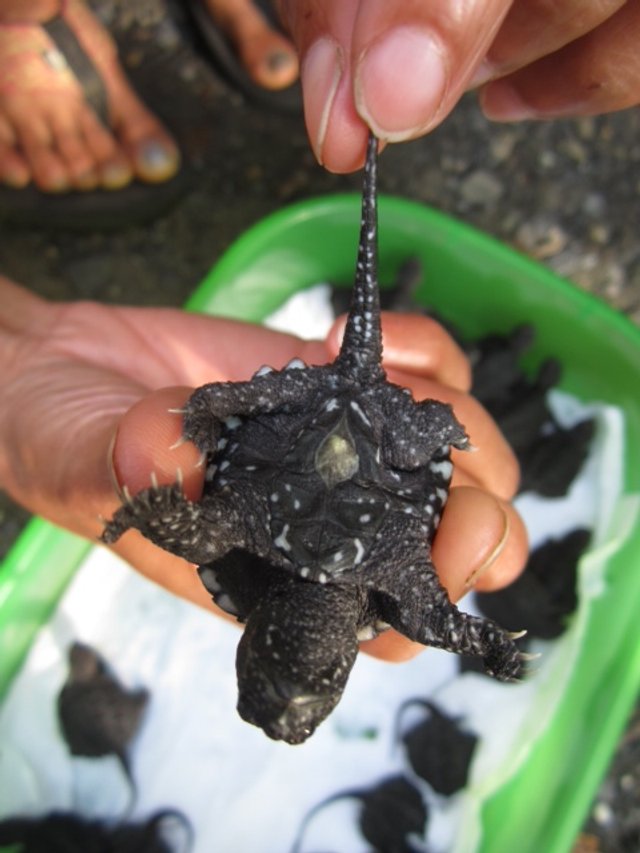
My heart leapt. There is nothing cuter than a baby snapping turtle, not even a kitten. They look like miniature dragons with oversized heads, fragile little shells and spunk. They are all purpose and who doesn’t love a creature that is fully itself, confident in its turtleness. A baby turtle is not yet the belligerent, large snapping adult they will become—when I love them even more.
My student’s lively story unfolded. A friend was building a house in Rhode Island and dug up a snapper nest. He gave her the eggs, which she proceeded to keep in a box of soil in a warm room all summer long. Her mother-in-law arrived from time to time to tell her to just throw out the eggs. But she held on, and finally last week little limbs started to emerge from the ping-pong sized eggs. It took several days for the babies to emerge; every single egg hatched. The turtles had been in the world for three days, living off of their yolk sacks. They now needed to be released.

In May, snapping turtles travel from the water to that just-right spot to lay their eggs. It is in May that we find snappers crossing the roads, or, sadly, crushed as they try and do so. I’ve come across snappers scooting into the soil, digging in deeper with hind legs in order to lay a clutch. And, I’ve found the eggs, like torn white leather, littering a hillside after a raccoon has had a good egg snack. And, I’d seen baby turtles marching toward their future, as uncertain as it is. But an entire clutch of baby turtles—I had never seen this before. Ignoring the legal aspect of this (in New York State, you are not allowed to take or transport reptiles), I told her (after consulting with a local ecologist) to bring the babies to the South Tivoli Bay for release.
At five thirty on a Thursday afternoon my student and her husband (who leads eco tours in Peru) arrived in a Prius down the steep rocky road to the Bard Field Station. She held a green plastic dish that contained the dark, eager little turtles. They had long pointed tails, and spiny backs. They clambered on top of each other, stretching their oversized heads toward the sky, trying to escape their plastic prison. On the route to this release, my student had found yet another baby snapping turtle on the road. She held this grey-looking turtle in one hand. We now had an excess of turtles to love.
the more quiet local turtleThe local turtle, huddled in its little shell was a contrast to the home-raised turtles, black and all flailing limbs. They had tiny beaks, which they had used to work their way out of their shells, and some still had a yolk sack on their stomachs. We admired their energy for a while, then went in search of a perfect release spot in the Saw Kill, which drops into the South Tivoli Bay. This Bay, wide and open, is somewhat sealed off from the larger Hudson River by the railroad tracks. It’s a perfect environment in which a turtle can grow.
When I kayak in the North and South Tivoli Bays I almost always see a V in the water. If it is a deep V I think Muskrat or Beaver. If it is a shallow V I think snapper, and look for their triangular-shaped heads moving through the water. I sometimes catch up to a turtle and watch the large, almost flat shells sink into the murk. I have often wanted to hop out of my boat and pursue the turtles as I’ve heard that snappers don’t snap in water. But I’ve seen them snap on land and the speed and strength of that keeps me snug in my boat.
We walked upstream, and as we approached the rush of water, the local turtle, which I held in one hand, came alive. It pushed against the palm of my hand with its sturdy legs, wanting to enter the water. I cupped it gently, then stooped to set it free on a flat rock near the moving water. It scrambled with no fear toward the edge of the rock and plunged into the water. I watched it pedal its legs in the clear stream as it was carried off in the current.
“Maybe we should release the other turtles in quieter waters,” I said. I worried that this turtle would be swept over a small falls, would be tossed about. Of course my worries were tame ones—this turtle had a lot more to worry about than a small falls, which it could surely navigate.
We scooped up the little turtles and plunked them into the stiller waters of a cove. They swam free, and then some returned to shore, clambered out on rocks, as if to say a final goodbye. They looked alert, ready for their new lives. But we, of course, we not ready to say goodbye, especially my student who had tended to them all summer long. We lingered, watching and laughing as they clambered about in their new home. And then we knew we had to leave. As we walked off I thought how wonderful it would be to know what happened to one of these small lives. And I thought how wonderful it was that I would never know.